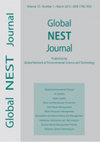ASSESSMENT OF THE CLIMATE CHANGE IMPACTS ON THE WATER RESOURCES OF THE LUNI REGION, INDIA
IF 1.2
4区 环境科学与生态学
Q4 ENVIRONMENTAL SCIENCES
引用次数: 15
Abstract
Climate change is expected to have a strong impact on water resources at the local, regional and global scales. In this study, the impact of climate change on the hydro-climatology of the Luni region, India, is investigated by comparing statistics of current and projected future fluxes resulting from three representative concentration pathways (RCP2.6, RCP4.5, and RCP8.5). The use of different scenarios allows for the estimation of uncertainty of future impacts. The projections are based on the CORDEXSouth Asia framework and are bias-corrected using the DBS method before being entered into the HYPE (HYdrological Predictions for the Environment) hydrological model to generate predictions of runoff, evapotranspiration, soil moisture deficit, and applied irrigation water to soil. Overall, the high uncertainty in the climate projections is propagated in the impact model, and as a result the spatiotemporal distribution of change is subject to the climate change scenario. In general, for all scenarios, results show a -20 to +20% change in the long-term average precipitation and evapotranspiration, whereas more pronounced impacts are expected for runoff (-40 to +40% change). Climate change can also affect other hydro-climatic components, however, at a lower impact. Finally, the flow dynamics in the Luni River are substantially affected in terms of shape and magnitude.气候变化对印度鲁尼地区水资源影响的评估
预计气候变化将在地方、区域和全球范围内对水资源产生强烈影响。本文通过比较RCP2.6、RCP4.5和RCP8.5三个代表性浓度路径的当前通量和预测未来通量的统计数据,研究了气候变化对印度鲁尼地区水文气候学的影响。使用不同的情景可以估计未来影响的不确定性。这些预测基于CORDEXSouth Asia框架,并在进入HYPE(环境水文预测)水文模型之前使用DBS方法进行偏差校正,以生成径流、蒸散发、土壤水分亏缺和土壤灌溉用水的预测。总体而言,气候预估的高不确定性在影响模式中得到了传播,因此变化的时空分布受气候变化情景的影响。总的来说,对于所有情景,结果显示长期平均降水和蒸散发的变化为- 20%至+20%,而径流的影响更为明显(变化为- 40%至+40%)。然而,气候变化也可以影响其他水文气候成分,但影响较小。最后,鲁尼河的流动动力学在形状和大小上都受到了很大的影响。
本文章由计算机程序翻译,如有差异,请以英文原文为准。
求助全文
约1分钟内获得全文
求助全文
来源期刊

Global Nest Journal
环境科学-环境科学
CiteScore
1.50
自引率
9.10%
发文量
100
审稿时长
>12 weeks
期刊介绍:
Global Network of Environmental Science and Technology Journal (Global NEST Journal) is a scientific source of information for professionals in a wide range of environmental disciplines. The Journal is published both in print and online.
Global NEST Journal constitutes an international effort of scientists, technologists, engineers and other interested groups involved in all scientific and technological aspects of the environment, as well, as in application techniques aiming at the development of sustainable solutions. Its main target is to support and assist the dissemination of information regarding the most contemporary methods for improving quality of life through the development and application of technologies and policies friendly to the environment
 求助内容:
求助内容: 应助结果提醒方式:
应助结果提醒方式:


